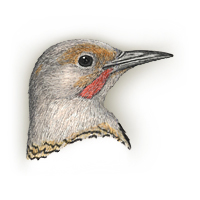|
Field
Guide IDs: BREEDING:
Nearly ubiquitous
below tree line where nest sites and open ground
for feeding occur together. 1 brood, 2 in
s. DISPLAYS:
Courtship: noisy,
active, with calling, drumming, wing and tail
flashing, billing, and bobbing while pair face each
other. Aggressive displays include bill pointing,
head swinging/bobbing, tail spreading. NEST:
Prefer snag; will
use variety of cavities: poles and posts, houses,
banks, haystacks, boxes. Occ usurp kingfisher and
Bank Swallow burrows. Cavities often perennial.
Excavation time varies, averaging 12 days; male usu
selects site. EGGS:
White. 1.1" (28
mm). DIET:
Esp ants (more than
any other N.A. bird); also occ seeds, acorns, nuts,
grain. Young fed regurgitant. CONSERVATION:
Winters within
N.A. NOTES:
Most terrestrial of
N.A. woodpeckers. Starlings, squirrels, screech
owls, kestrels may usurp holes. Large clutch sizes
usu represent output of 2 females. Both sexes
brood, but mostly female. Hybrid zone between
Yellow- and Red-shafted subspecies appears stable;
no evidence for preferential mating of birds with
similar plumage-types within hybrid zone. Early
clutches larger than later ones; clutches larger in
n. Clutches of Gilded Flicker subspecies
significantly smaller, avg 4. The "Red-shafted"
form is an uncommon to fairly common migrant and
winter resident throughout campus. Less common in
summer, though a few pairs likely breed on campus.
Often forages in mature trees, but forages on the
ground (usually on ants) more often than any other
woodpecker. "Yellow-shafted" Flickers and
intergrades between Red-shafted and Yellow-shafted
are fairly rare on campus, occurring occasionally
in fall and winter. ESSAYS: Variation
in Clutch Sizes;
Great
Plains Hybrids;
Walking
vs. Hopping;
Species
and Speciation;
Average
Clutch Size;
Hybridization REFERENCES:
Grudzien et al.,
1987; Koenig, 1984; Moore and Koenig,
1986. |
